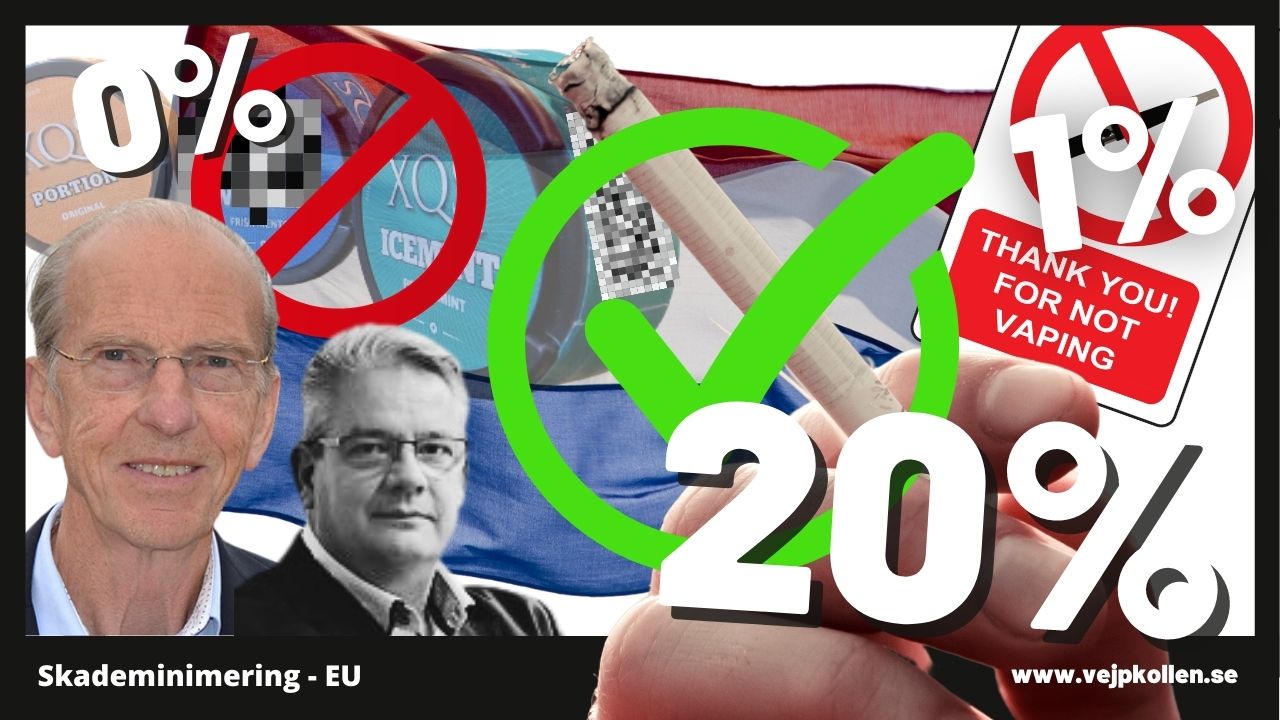The Netherlands recently banned all savoury flavours in e-liquid and only allows nicotine portions with the same nicotine content as aubergines.
Now they want to further tighten the law and ban all nicotine pouches, just to be on the safe side.
What happens in a country where cannabis is allowed to flow relatively freely, but all alternatives to cigarettes are seen as the devil's invention? Vejpkollen asked activist Rob de Lange and the inventor of the nicotine pouch, Karl Fagerström.
Following a proposal by the Dutch government to total ban on nicotine pouches there has been a marked increase in the level of commitment to harm reduction in the country. But this is happening in a country where resistance to new nicotine products is deeply rooted, with a flavour ban for e-cigarettes since the beginning of the year and a highly medicalised approach to nicotine.
"Harm reduction and smoking cessation is only about medicines like nicotine tablets and patches here. It's hard to get anyone to listen to us consumers. It has become a toxic environment around anything related to harm reduction." notes Rob de Lange, involved in the association Acvoda which has been working since 2013 to promote harm minimisation for the nearly 3.5 million people who smoke in the Netherlands.
"It's slow going," he says. While virtually all flavours are now being phased out from the shelves of vejp shops, the government is also targeting nicotine pouches. All products that have the potential to lure nicotine users away from the deadly habit of inhaling smoke day in and day out to get their fix will be removed. Almost. Because while the Netherlands has become a nightmare for vejpers and snus users - the country is also a wet dream for those interests who think that nicotine should only be sold as medicinal products.
Nicotine portions = vegetables
Nicotine pouches in the Netherlands are a complicated story. The products are already, technically, on the market. But with a very low nicotine strength, equivalent to the nicotine content of an aubergine. The reason for this is that the pouches, which are made of plant cellulose, are regulated as vegetables, with all that implies Since many vegetables contain nicotine naturally, legislators have decided that the aubergine - which contains the most natural nicotine - should be the benchmark for other products in the segment.
"It's ridiculous really. With such low levels of nicotine, nicotine pouches are neither attractive nor a viable tool for smokers to quit smoking," said Mr Perez. Rob de Lange.
Chewing gum not attractive to smokers
Ironically, it was precisely restrictions on nicotine content that led to the development of the modern nicotine pouch. Karl Fagerström, a Swedish doctor of psychology, addiction researcher and inventor, had been working on smoking cessation products since the mid-1970s. He was involved in the development of both nicotine chewing gum and nicotine patches, but also recognised the limitations of these products when it came to smoking cessation.
"The problem was that many smokers didn't really like using these products. They got heartburn and other side effects and soon went back to the cigarettes again," says Mr Perez. Karl Fagerström to Vejpkollen when we talk about how the nicotine pouch evolved in the early 2000s.
Swedish snus inspiration
For Karl Fagerström it was the experience of the smoking cessation philosophy of the 1980s and 1990s that inspired the development of better tools to help smokers quit.
"I come from a country where many people use snus instead of smoking. And they obviously liked it, because many Swedes stopped smoking that way. But what would happen if you combined the pure nicotine we used in nicotine patches and chewing gum, packaged it in a bag and used it as snus?".
Too weak as a medicine
And so the first nicotine pouch was born. The problem was the nicotine content. As a medicine, the only reference was nicotine gum, where the highest concentration tested was 4 mg.
"The equivalent amount in snus is close to 10 mg - and this was one of the reasons why Swedish snus has become significantly more effective in smoking cessation than other products on the market," notes Karl Fagerström.
But spending millions trying to get a stronger product authorised as a medicine was not possible, he says.
"So I had to give up. Nicotine pouches with such low nicotine content didn't work the way I wanted. It was only when products like e-cigarettes appeared on the market that things actually started to change. The EU approved e-liquid as a mainstream consumer product in 2015. Since the nicotine content was allowed to be 20 mg/ml in the e-juice, it also opened the door for the new nicotine pouch - not as a medicine but as a product on the open market," says Ms. Higgins. Karl Fagerström.
Replacing smoking in Sweden
The modern nicotine pouch usually has a nicotine content of between 6 and 12 mg - a concentration that delivers nicotine equivalent to Swedish snus. The difference was the wide variety of flavours that could be combined with the nicotine. The products are popular in Sweden and today the pouches, together with snus and e-cigarettes, have replaced smoking in many groups in Sweden. 4% of men smoke while 20% use snus (this includes nicotine pouches).
Women, who have long smoked more than men in Sweden, have also started using nicotine pouches - especially young women. Between 2015 and 2022, the proportion of women 16-29 who smoke daily decreased from 11 per cent to 4 per cent. At the same time, the proportion of people who use nicotine in this group is around 15 per cent. 8 per cent use e-cigarettes.
"Since the introduction of nicotine pouches, we have seen smoking decline, and almost disappear, in different population groups. And it is the consumers who choose, not doctors or smoking cessation specialists, it is important to point out. At the same time, perhaps a certain fashion has emerged, where young people who did not smoke have started using nicotine pouches. Many of them might have started smoking anyway, but we don't know that." says Karl Fagerström.
Clear impact on smoking
Nicotine pouches, along with snus and e-cigarettes have simply been proven to work. as a substitute for cigarette smoking. And this is not only true in countries like Sweden and Norway. Similar developments can be seen in United Kingdom, USA and New Zealand, where smoking is declining at a faster rate than in countries that, in one way or another. limits access to smoke-free nicotine alternatives. Nicotine medicines as the only smokeless nicotine source has simply proven to be less effective than other products on the open market. At least in terms of reducing the number of smokers, which is something that many say is the whole point with the products.
Consumers are being ignored
But there is little hope that the Dutch government will reverse its position on harm minimisation. At least according to activist Rob de Lange. He and his organisation Acvoda have repeatedly tried to persuade the government to include a consumer perspective in nicotine policy.
"There have been times when we have appeared in the media to give our point of view. But we always get less time and attention than our opponents. So far, we have not been allowed to participate in any debates where politicians are present," says Mr Perez. Rob de Lange.
E-cigarettes should taste bad
The Dutch flavour ban for e-cigarettes is also one of the most elaborate in the world. In short, from 2023, e-liquid can only be flavoured with 11 different flavourings. These flavours are characterised by the presence of hay, rotten wood and ash. According to a government investigation, these 11 flavourings make an e-cigarette "taste like tobacco smoke" - something that should keep both young and old away from the products. In the face of the flavour ban, Acvoda members demonstrated outside Parliament.
"We had a brief chat with the Minister of Health. But once inside the Chamber, he said that the ban was not aimed at the "nice vejps" demonstrating outside. The ban was to prevent young people from vejping. So they are well aware that the ban affects us, but they simply ignore it," he said. Rob de Lange to Vejpkollen.
20 per cent smoke in the Netherlands
Whether it's e-cigarettes or nicotine pouches, the Dutch attitude towards alternative nicotine products is limiting the country's ability to reduce smoking in the country, according to the report. Karl Fagerström. The goal is to have less than 5% of the population smoking by 2040. Currently, nearly 20 per cent of the adult population smokes.
Should allow options
Along with around 10 other Swedish researchers and interest groups, he is now trying to get the Dutch government to reconsider:
"Bans and restrictions on products that have the potential to help smokers quit should not be implemented lightly. With so many people smoking, the government should instead invest more in getting smokers to quit, or switch to less harmful products. If you want to reduce smoking to the same low levels as in Sweden, consumers should be able to choose alternative sources of nicotine." Writes Karl Fagerström in a letter to the Dutch government.
"Tightly regulate nicotine"
He also points out that the regulation of new nicotine products must be very strict, as in Sweden.
"Age limits and marketing restrictions, content controls and an upper limit on nicotine content are essential. At the same time, even more stringent restrictions on cigarettes and cigarette sales should be introduced in parallel," the report says. Karl Fagerström.
Almost religious resistance
Rob de Lange argues that the damage minimisation situation in the Netherlands is unlikely to change in a hurry. Rational arguments don't seem to bite politicians, notes Rob de Lange.
"There are almost religious undertones in the resistance. A bit like suffering is part of life and that it should be difficult to stop smoking - certainly not pleasurable. This is coupled with a precautionary principle that says "We should not make the same mistakes as with cigarettes". Add to this the strong influence of biased 'experts' and anti-tobacco activists and it's hard to hope for too much," says Mr Perez. Rob de Lange to Vejpkollen.





Well, in the Netherlands it is particularly absurd given their liberal attitude to cannabis. The Sossars in Sweden are at least fairly consistent when it comes to opposing all forms of drugs and stimulants regardless of the risks.
Again, the anti-nicotine and tobacco lobby are prohibitionist fascists, sadists, control freaks and totalitarian fanatics. Some of them probably suffer from mental disorders. This is evidenced by the fact that they do not want to allow alternative methods of consuming nicotine, which in principle are no more dangerous than, for example, coffee drinking and moderate wine consumption. The fact that they also want to ban tobacco-free snus shows that it's not even just about vejping because to them it's "immoral because it looks like you're smoking". Then there are also some people who do not want to stop smoking cigarettes and who have tried different alternatives and did not like them. I myself know a couple of such people. The prohibitionist fascists should just leave them alone.